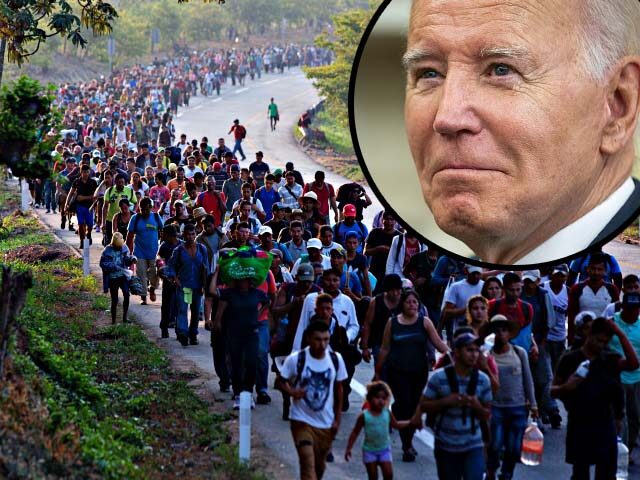President Joe Biden’s staffers are asking Congress for more than $13 billion in taxpayer funds to help move many more economic migrants into homes and workplaces in American communities.
Much of the money will be used to bail out the sanctuary cities that help displace Americans by welcoming migrants who serve as lower-wage workers, apartment-sharing renters, and taxpayer-aided consumers.
The 2025 funding is being requested by two pro-migration cabinet members — Secretary of State Antony Blinken and Alejandro Mayorkas, the Cuba-born head of the Department of Homeland Security.
Their plans are outlined in the 2025 budget request to Congress, released on Monday, March 11. The funding request likely will be approved unless the GOP wins a House and Senate majority in November. If approved, the 12 months of spending could begin on October 1, 2024.
"They kind of called the Democrats’ bluff about sanctuary cities, and they said, 'Oh, you love them so much? Here you go.' And the cities don’t like it so much." https://t.co/1wtNwl90NN
— Breitbart News (@BreitbartNews) October 7, 2023
Biden’s huge inflow of migrants has already delivered one illegal or legal migrant for every American born during his tenure. That massive planned inflow has suppressed wages, inflated housing prices, and diverted investment from high-tech jobs to cheap-labor taxpayer-funded jobs.
For example, President Donald Trump’s slow-motion curbs on migration prompted U.S meatpacking companies to develop and buy technology that helps American meatpackers safely get more work done — and earn more pay. But Biden’s disposable, cheap-labor migrants are now being recruited by meatpacking companies, according to a Bloomberg News report that was tagged as an “equality” article:
Tyson [Foods Inc.] is constantly in search of workers to fill jobs in its factories — tasks like washing meat, placing the cuts into trays and doing a final inspection for bones. Dolan says the company expects about 40% of the 100,000 people in these roles will leave each year, a statistic he says is standard across the meatpacking industry. To meet this need, he said, Tyson plans to hire about 52,000 people at that wage class — which starts at $16.50 an hour, plus benefits — in 2024 alone.
Biden told MSNBC on March 9 that he wants a “more orderly flow” of southern migrants into jobs around the nation because “they’re the reason our economy is growing.”
However, at least 5 million Americans have fallen out — or been pushed — of the workforce because of crime, drugs, and other failures. Polls show that a majority of Americans want less legal and illegal migration.
Homeland Security
Mayorkas’ budget request asks for $4.7 billion for the “Southwest Border Enforcement Capacity Flexibility” (SWBCF) account, saying:
Resources in the SWBCF may be transferred to CBP, ICE, and the Federal Emergency Management Agency (FEMA) for critical operations like transportation, medical care, soft-sided facilities, and Shelter and Service Program grants.
Mayorkas also asked for Congress to provide at least $5 billion in city bailout funds that were blocked by GOP Senators in February. This funding is intended to support the economic migrants who have already flooded through the semi-open border with Mexico.
Some of the disaster funding would go to the nationwide network of non-government organizations, cities, and towns that transport, feed, shelter, and hide migrants. The network is dubbed the “Northside Migration Cartel” by Jessica Vaughan of the Center for Immigration Studies.
"Some of the most liberal people are like, oh, this doesn’t work for us.” https://t.co/iYSoTtymdS
— Breitbart News (@BreitbartNews) February 18, 2024
The non-government organizations that are paid to help the migration include Catholic Charities.
The bailout funding is vital for Democratic politicians, many of whom are cutting spending on Americans to help fund the shelters that hide the migrants from local TV news stations.
False.
— Mr T 2 (@GovtsTheProblem) March 6, 2024
Illegal immigrants are everywhere. https://t.co/ODDuvpWFsE
Much additional funding may be hidden in other agency accounts. For example, agency officials can quietly divert funds from vaguely named accounts toward the cities and non-government organizations. The budget document says:
The Budget includes $22.7B for the Disaster Relief Fund (DRF) – Major Disasters, which enables FEMA to fund authorized disaster support activities. The DRF Base requirements total $811.0M and will be funded from prior years’ resources.
The agency request also asks for more funds to bring in more legal refugees, saying, “The Budget includes $145.0M and 641 FTE [Full-Time Equivalent employee] to fully support the [agency’s] USCIS International and Refugee Affairs Division, a partner in the U.S. Refugee Admissions Program.”
In contrast, the department only asks “$849 [million] for cutting-edge [drug] detection technology at ports of entry,” despite the annual death of 70,000 Americans from smuggled fentanyl drugs.
State Department
The Department of State is asking for $3.8 billion to import more workers, consumers, and renters who are selected via the “Migration and Refugee Assistance” programs.
The document says:
The Request provides the resources necessary to fully support the refugee admissions program and will fund contributions to such organizations as the UN High Commissioner for Refugees (UNHCR), the International Committee of the Red Cross (ICRC), and the International Organization for Migration (IOM) as well as other international and non-governmental organizations that address pressing humanitarian needs overseas and resettle refugees in the United States.
Those groups provide debit cards and other aid to migrants to help them reach the United States via Central America.
A sea of African migrants outside the Mexican COMAR immigration offices to get papers in Tapachula, Mexico near the Guatemala border. Later@they will try for UN cash debit cards. They are Senegalese, Nigerians, Angolans and Ghanians. They tell me so@e Somalis are here pic.twitter.com/8BVsgPfWeN
— Todd Bensman (@BensmanTodd) January 17, 2022
The $3.8 billion fund includes $1.2 billion to bring 125,000 refugees from poor countries straight into U.S. cities and towns, such as the Congo.
The $1.2 billion will also be used to help private-sector U.S. groups — in the so-called “Welcome Corps” — to import their own migrants. These migrants are used to fill jobs that would otherwise go to better-paid Americans.
In December 2023, DocumentedNY.com described the story of one Haitian among the roughly 107,000 Haitians permitted to enter the United States:
Jemimah was a kindergarten teacher in Port-au-Prince. She dreamed of working in New York schools but couldn’t meet the requirements. She wanted to have a job so she could help her three siblings and her mother in Haiti. Now she wants to save money while in the U.S. to establish a school upon returning to Haiti. Eight months after arriving in New York, she works as a part-time babysitter.
The state department’s funds will also be used to operate more “Safe Mobility Offices.” These offices are being opened in South America and elsewhere so that foreigners can get legal permission to fly into the United States without having to pay smugglers and cartels to reach California and Texas — or be included in Mayorkas’ monthly reports on illegal migration.
The department also plans to fund the arrival of diverse migrants from Afghanistan, various sexual minorities, and Muslim “Royhinga” migrants from near India. The document says:
priorities in FY 2025 include the continued expansion of the Welcome Corps, a new private sponsorship program that empowers everyday Americans to play a leading role in welcoming refugees; continued expansion of legal pathways through the Safe Mobility Office initiative in the Western Hemisphere; expanded opportunities under for Afghans at-risk due to their affiliation with the United States under the Administration’s longer-term, sustainable resettlement operation “Enduring Welcome”; greater access to resettlement for LGBTQI+ refugees through increased NGO direct referrals and private sponsorship; continued efforts to build domestic resettlement capacity and expand the traditional resettlement agency network; expand resettlement of Rohingya in Bangladesh and increase resettlement opportunities for Rohingya globally, and continue to build the Resettlement Diplomacy Network and U.S.-led efforts to increase resettlement capacity and resettlement infrastructure globally.
Some of the money will be used to import more Afghan migrants, according to the request:
In FY 2025, the Department plans to continue to process and support the country’s Afghan allies at several overseas locations. For example, CARE Doha (previously Camp As Sayliyah) in Qatar continues to serve as the primary overseas platform for processing applications for individuals relocated from Afghanistan. In addition, the Department is focused on SIV processing in Tirana, Albania, and is increasing capacity to process SIV and refugee applicants in Pakistan. The State Department continues to strive to bring online additional processing capacity in the East Asian and Pacific Affairs areas of responsibility.
The budget also asks for $100 million to fund “Emergency Refugee and Migration Assistance” or ERMA. Roughly $50 million was spent in 2023 to aid “the urgent humanitarian needs of vulnerable migrants in the Western Hemisphere.”
The document noted that officials already have $1.6 billion in the ERMA account:
As of the start of FY 2024, a total of $1.571 billion in ERMA also remained available separately for the purposes of meeting unexpected urgent refugee and migration needs to support Enduring Welcome and related efforts by the Department of State in Afghanistan, including additional travel and related expenses for individuals at risk.
The State Department also wants $650 million in new funds for Ukrainian migrants. But the request does not say if the money will be used to shift Ukrainians into U.S. communities.
A recent report claimed that the federal government earns profits from refugees — but it excluded many costs as well as marketplace costs to Americans.
The White House’s push for more migration is both ideological and economic.
Mayorkas has repeatedly explained that he supports more migration because of his migrant parents, his sympathy for migrants, his support for “equity” between Americans and foreigners, and his willingness to put his priorities above the law.
So he is eager to claim that U.S. business “needs” migrants — regardless of the cost to ordinary Americans, the impact on U.S. children, or Americans’ rational opposition. Since 2021, he has created a series of legally contested “legal pathways” for migrants to flow into jobs and homes through the United States.
A new report from the Congressional Budget Office reinforces the vast evidence that the federal policy of Extraction Migration shifts family wages and workplace investment toward Wall Street, real estate, coastal states, and government.




